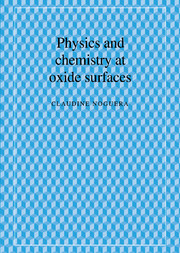1 - Introduction
Published online by Cambridge University Press: 24 September 2009
Summary
This first chapter summarizes the main bulk characteristics of insulating oxides, as a prerequisite to the study of surfaces. The foundations of the classical models of cohesion are first recapitulated, and the distinction between charge-transfer oxides and correlated oxides is subsequently established. Restricting ourselves to the first family, which is the subject of this book, we analyse the mixed iono–covalent character of the anion–cation bonding and the peculiarities of the bulk electronic structure. This presentation will allow us to introduce various theoretical and experimental methods – for example, the most common techniques of band structure calculation – as well as some models – the partial charge model, the alternating lattice model – which will be used in the following chapters.
Classical models of cohesion
Ionic solids are made up of positively and negatively charged ions – the cations and the anions, respectively. The classical models postulate that the outer electronic shells of these ions are either completely filled or empty, so that the charges have integer values: e.g. O–– (2p6 configuration) or Mg++ (3s0 configuration). The strongest cohesion is obtained when anions and cations are piled up in an alternating way – the anions surrounded by cations and vice versa –, a stacking which minimizes the repulsion between charges of the same sign.
The hard-sphere model
In the first models, due to Born and Madelung, the ions are described as hard spheres, put together in the most compact way (Kittel, 1990).
- Type
- Chapter
- Information
- Physics and Chemistry at Oxide Surfaces , pp. 1 - 41Publisher: Cambridge University PressPrint publication year: 1996
- 2
- Cited by

